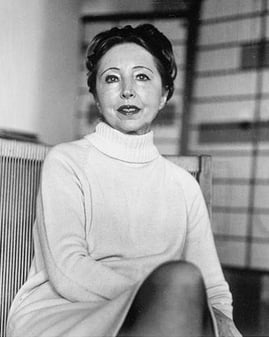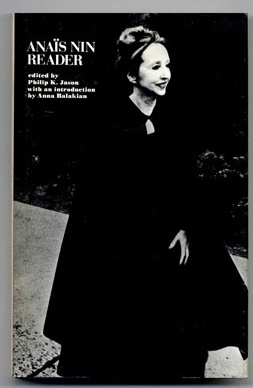Anaïs Nin, born Angela Anaïs Juana Antolina Rosa Edelmira Nin y Culmell in 1903, was the daughter of Cuban expats living in France. Though her early life was spent in Spain and France, her family moved to the United States when she was young. All of Nin's work was written and published in English. As a diarist, novelist, short story writer, and critic, Nin was embraced by the feminist movement in the 1960s, bringing a renewed interest to the craft she had honed her entire life. But before this recognition, Nin struggled to achieve any kind of success, self-publishing four out of the nine books she published in her lifetime. Despite a lack of enthusiasm for her work throughout the majority of her life and a scandal that erupted after her death that caused a temporary cessation in the publication of her work, she is today regarded as a feminist icon and pioneer in the melding of fiction and autobiography. She is likewise celebrated for her bold depictions of sex, abortion, incest, and other topics that were at the time taboo.
Anaïs Nin: Early Life and Work
 Nin developed an interest in literature early in her life. She discovered a cache of erotic novels left by a tenant in a room when she was visiting Paris with her husband and family in her late teens, and she had an intense love of keeping a diary, a practice she maintained her entire life and which yielded much of the work for which she is celebrated.
Nin developed an interest in literature early in her life. She discovered a cache of erotic novels left by a tenant in a room when she was visiting Paris with her husband and family in her late teens, and she had an intense love of keeping a diary, a practice she maintained her entire life and which yielded much of the work for which she is celebrated.
In spite of her love of literature, Nin had dropped out of high school at sixteen to be an artist's model. During this time, she met and married her first husband, wealthy banker Hugh Parker Guiler. Together, they moved to Paris in 1923.
In Paris, Nin wrote what would become Vol.1, 1931-1934 of her published diaries. Guiler did not wish to be part of her published works and so his presence had mostly been edited out of her diaries. As a result, it is difficult to gauge the nature of their relationship and his role in her work and day-to-day life. Nin had an interest in psychoanalysis which led to an affair with prominent psychoanalyst Otto Rank as well as several patients when she herself worked as a practicing psychoanalyst.
It was also during this time that Nin met Henry Miller. Miller was attempting and failing to support himself as a writer. As a huge fan of his work, Nin began financially supporting Miller using money from her husband and from Otto Rank. Nin supported Miller throughout the 1930s and had an affair throughout much of this time, which is detailed in her journals. She believed Miller to be the father of the fetus she aborted in the 1940s.
In addition to providing food and housing for Miller, she also financed the publication of Tropic of Cancer, effectively launching his career. After that, she became a sought-after friend to struggling artists who were eager to make her acquaintance, impress her, and hopefully benefit from her generosity when it came to supporting work she loved.
Nin's Fiction and Secrets
In 1936, Nin published her first fictional work, House of Incest. Though it was later revealed in a posthumous unexpurgated diary that Nin had been sexually abused by her father as a child and later had a sexual relationship with him in her thirties, the premise of the seventy-two page novel is an exploration of the incestuous and conceited self-love that allows people to only love in others the things the recognize as being similar to themselves. Largely allegorical and symbolic, the novel is influenced by Nin's experience with psychoanalysis.
 Since the publication of her diary detailing her real life experience with incest and the knowledge that the novel was written during the time she was engaging in an incestuous relationship with her father as an adult, it has become increasingly common for modern critics to read more into the symbolism of the novel as it pertains to her experiences with incest. Simultaneously, Nin wrote the manuscript that would become Winter of Artifice, which she released in 1939 and again in 1942 in a hand-printed edition created by herself, her lover Gonzalo More, and her husband Guiler.
Since the publication of her diary detailing her real life experience with incest and the knowledge that the novel was written during the time she was engaging in an incestuous relationship with her father as an adult, it has become increasingly common for modern critics to read more into the symbolism of the novel as it pertains to her experiences with incest. Simultaneously, Nin wrote the manuscript that would become Winter of Artifice, which she released in 1939 and again in 1942 in a hand-printed edition created by herself, her lover Gonzalo More, and her husband Guiler.
In 1947, Nin met actor Rupert Pole in an elevator in Manhattan and ended up moving with him to California. They married unbeknownst to her still-husband Guiler, and Nin began what she referred to as a “bicoastal trapeze,” moving between California and Manhattan while maintaining two separate lives with her two separate husbands. Due to a tax issue in which both men claimed her as a dependent in 1966, Nin's marriage with Pole was annulled, but the relationship continued.
Nin and the Feminist Movement
In the 1960s, the feminist movement sparked a new interest in Nin as a diarist and fiction writer, and she was invited to speak at universities across the world, though as recently as 1954 she had thrown a book release party in which none of the critics she had invited showed up. Publishers that had rejected her for years were seeking her out and essays were published exploring her work. She began publishing erotic fiction, some of which she had written years earlier.
 In 1977, Nin passed away from cervical cancer at the height of her popularity. A small scandal broke out when two newspapers in her two different cities of residence published conflicting obituaries stating two different grieving husbands. It was later revealed through letters that while Guiler did not know for some time, she had written him a letter of apology, and he had responded with forgiveness and a comment on how much meaning she had brought to his life.
In 1977, Nin passed away from cervical cancer at the height of her popularity. A small scandal broke out when two newspapers in her two different cities of residence published conflicting obituaries stating two different grieving husbands. It was later revealed through letters that while Guiler did not know for some time, she had written him a letter of apology, and he had responded with forgiveness and a comment on how much meaning she had brought to his life.
Much of her work including short stories, novels, and diaries has been published posthumously, and she remains a polarizing figure in literature as critics continue to debate whether or not she is a feminist icon or a self-obsessed egotist. Her impressive accomplishments as a diarist and her often avant gard fiction surely merits attention either way, offering a fascinating exploration of the life of a complicated woman and an important voice in feminist literature.
Image source.









